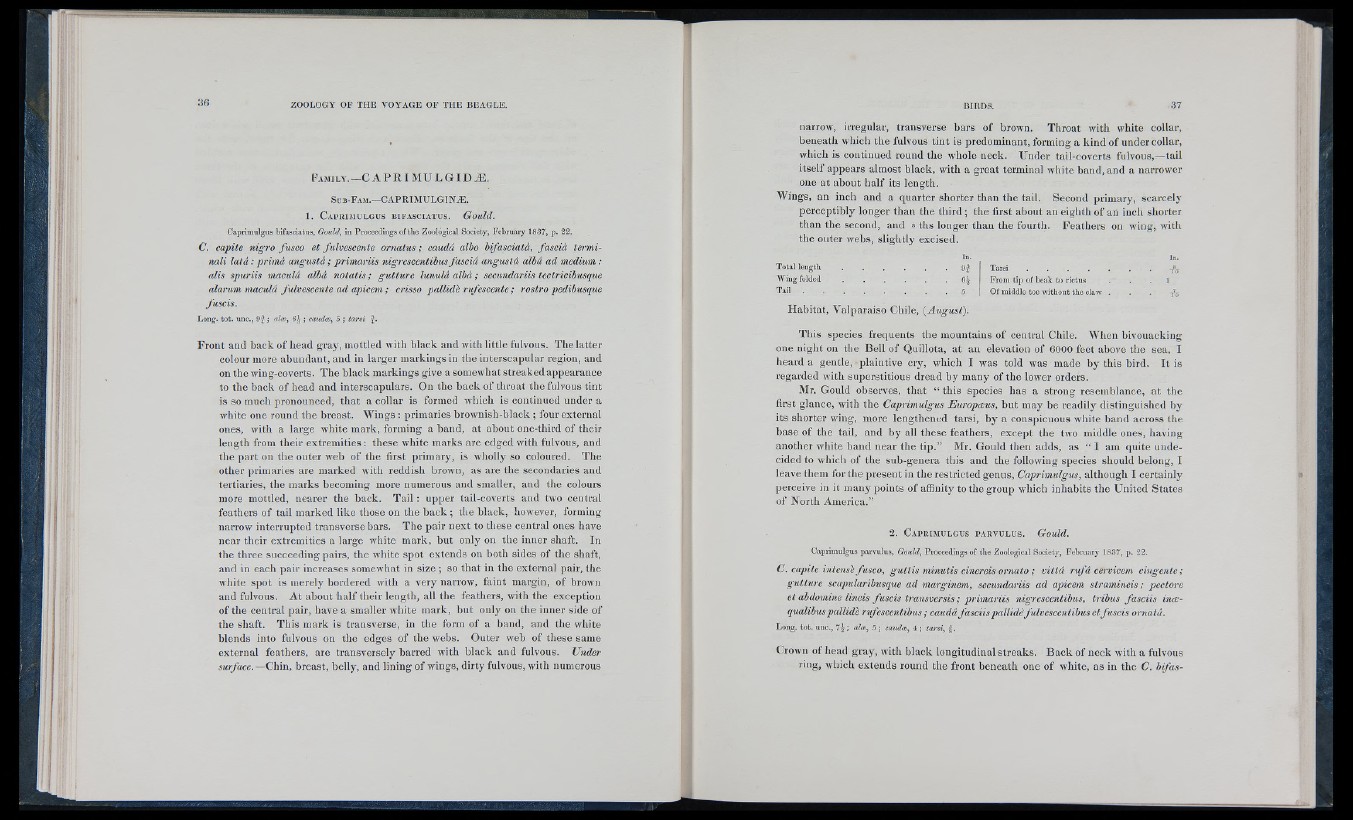
F a m i l y .— C A P R I M U L G I D Æ .
S u b - F am .— CAPRIMULGINÆ.
I. C a p r im u l g u s b i f a s c i a t u s . Gould.
Caprimulgus bifasciatus, GoidJ, in Proceedings of the Zoological Society, February 183T, p. 22.
C. capite nigro fusco et fulvescente ornatus ; caudd albo bifasciatd, fascici terminali
latà: primâ angusta; primariis nigrescentibusfasciâ anguslâ albâ ad medium :
alis spuriis macula albâ notatis; gutture lunulâ albâ ; secundariis tectricibusqtie
alarum macula fulvescente ad apicem ; crisso pallidè rufescente ; rostro pedibusque
fuscis.
Long. tot. une., 9^ ; aloe, Gj ; caudæ, 5 ; (arsi f .
Front and back of head gray, mottled with black and with little fulvous. The latter
colour more abundant, and in larger markings in the interscapular region, and
on the wing-coverts. The black markings give a somewhat streaked appearance
to the back of head and interscapulars. On the back of throat the fulvous tint
is so much pronounced, that a collar is formed which is continued under a
white one round the breast. Wings : primaries brownish-black ; four external
ones, with a large white mark, forming a band, at about one-third of their
length from their extremities : these white marks are edged with fulvous, and
the part on the outer web of the first primary, is wholly so coloured. The
otlier primaries are marked with reddish brown, as are the secondaries and
tertiaries, the marks becoming more numerous and smaller, and the colours
more mottled, nearer the back. T a il: upper tail-coverts and two central
feathers of tail marked like those on the hack ; the black, however, forming
narrow interrupted transverse bars. The pair next to these central ones have
near their extremities a large white mark, but only on the inner shaft. In
the three succeeding pairs, the white spot extends on both sides of the shaft,
and in each pair increases somewhat in size ; so that in the external pair, the
wliite spot is merely bordered with a very narrow, faint margin, of brown
and fulvous. At about half their length, all the feathers, with the exception
of the central pair, have a smaller white mark, but only on the inner side of
the shaft. This mark is transverse, in the form of a band, and the white
blends into fulvous on the edges of the webs. Outer web of these same
external feathers, are transversely barred with black and fulvous. Under
surface.—Chin, breast, belly, and lining of wings, dirty fulvous, with numerous
narrow, irregular, transverse bars of brown. Throat with white collar,
beneath which the fulvous tint is predominant, forming a kind of undercollar,
which is continued round the whole neck. Under tail-coverts fulvous,—tail
itself appears almost black, with a great terminal white band, and a narrower
one at about half its length.
Wings, an inch and a quarter shorter than the tail. Second primary, scarcely
perceptibly longer than the third; the first about an eighth of an inch shorter
than the second, and s ths longer than the fourth. Feathers on wing, with
the outer webs, slightly excised.
Total length
Wing folded
Tail .
Tarsi . . . .
From tip of beak to rictus
Of middle toe without the claw
Is
1
TC
Habitat, Valparaiso Chile, (Atigust).
This species frequents the mountains of central Chile. When bivouacking
one night on the Bell of Quillota, at an elevation of 6000 feet above the sea, I
heard a gentle, plaintive cry, which I was told was made by this bird. It is
regarded with superstitious dread by many of the lower orders.
Mr. Gould observes, that “ this species has a strong resemblance, at the
first glance, with the Caprimulgus Europceus, but may be readily distinguished by
its shorter wing, more lengthened tarsi, by a conspicuous white band across the
base of the tail, and by all these feathers, except the two middle ones, having
another white band near the tip.” Mr. Gould then adds, as “ I am quite undecided
to which of the sub-genera this and the following species should belong, I
leave them for the present in the restricted genus, Caprimulgus, although I certainly
perceive in it many points of affinity to the group which inhabits the United States
of North America.”
2 . C a p r im u l g u s p a u v u l u s . Gould.
Caprimulgus parvulus, Gould, Proceedings of the Zoological Society, February 1887, p. 22.
C. capile intensé fusco, guttis minutis ciñereis ornato ; vitta rufâ cervicem cingente;
gutture scapuïarihusque ad marginem, secundariis ad apicem stramineis; pectore
et abdomiue lineis fuscis traiisversis ; primariis nigrescentibus, tribus fasciis inoe-
qualibus pallidè rufescentibus ; caudâ fasciis pallidêfidvescentibus et fuscis ornata.
Long. tot. une,, 7 | ; aloe, 5 ; caudæ, 4 ; (arsi, | .
Crown of head gray, with black longitudinal streaks. Back of neck with a fulvous
ring, wliich extends round the front beneath one of white, as in the C. bifas